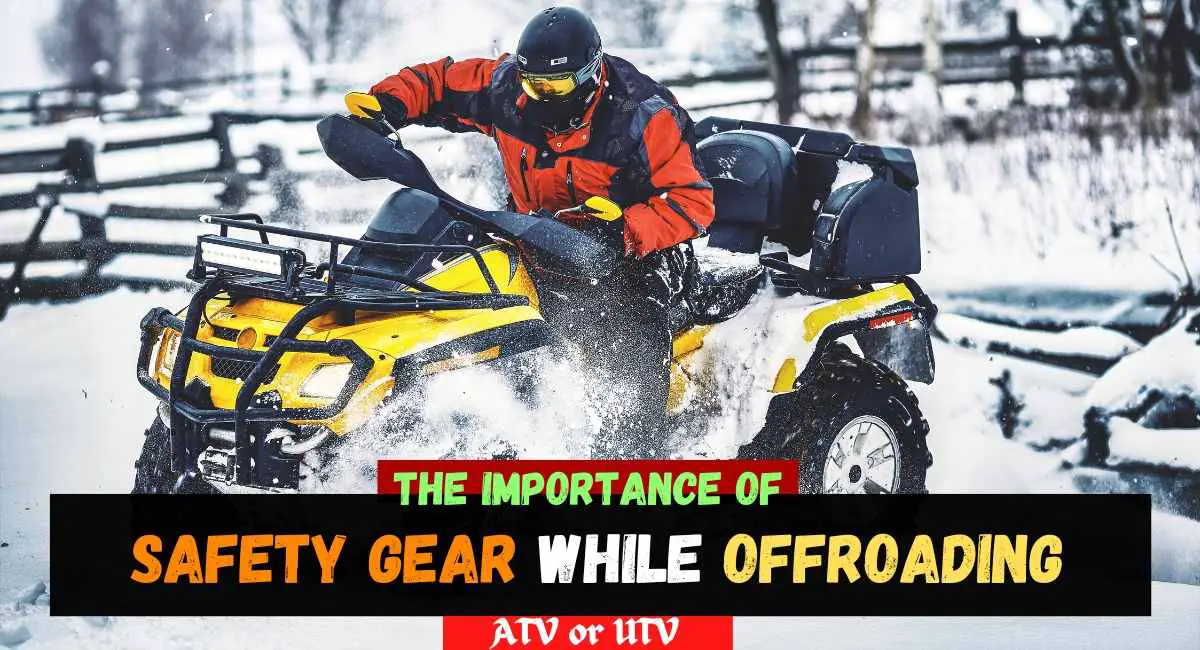Offroading with an ATV or UTV is an elating adventure that allows individuals to explore rugged terrains and embrace the thrill of the outdoors. However, amidst the excitement, it is crucial to prioritize safety and understand the significance of wearing appropriate safety gear.
By its very nature, offroading poses inherent risks and challenges. The unpredictable nature of offroad environments, combined with the power and speed of ATVs and UTVs, underscores the need for protective measures. Safety gear acts as a critical line of defense, safeguarding riders from potential hazards and minimizing the severity of injuries in case of accidents or unforeseen circumstances.
In this article, we’ll discuss the importance of donning safety gear while offroading with ATVs or UTVs. We’ll also highlight the various protective equipment available and emphasize the significant role they play in ensuring the well-being of riders.

Importance of Safety Gear for ATV or UTV
Safety should always be the top priority while offroading with ATVs or UTVs. Investing in and wearing the appropriate safety gear can significantly reduce the risk of injuries and ensures a safer and more enjoyable offroad experience. Let’s highlight the importance of safety gear while offroading with ATV or UTV;
Injury prevention- Safety gear provides essential protection, reducing the risk of injuries in case of accidents, falls, or collisions. Wearing safety gear provides crucial protection against impacts, while reducing the severity of injuries in case of accidents or falls.
Head protection- Wearing safety gear plays a vital role in providing head protection during offroading with ATVs or UTVs. The head is particularly vulnerable to injuries during offroading activities. As such, wearing the appropriate safety gear designed for head protection can help reduces the risk of serious head trauma, skull fractures, and traumatic brain injuries.
Eye protection- Offroading involves high speeds, which increases the risk of eye injury from debris, dust, or branches. Wearing eye protection help shields the eyes and face, preventing injuries caused by foreign objects and ensuring clear vision.
Impact absorption- Offroad environments can be unpredictable, especially when cruising through rough terrain, mud and other obstacles. Utilizing safety gear can help absorb and distribute the impact energy, lessening the severity of injuries in case of falls or accidents.
Protection against abrasions and burns- Most offroad trails often present hazards such as rocks, branches, or rough surfaces. Wearing the appropriate safety gear helps protect against abrasions, cuts, and lacerations that may occur during contact with rough surfaces or hot engine parts.
Joint and limb protection- Riding on rough offroad trails can put significant stress on joints and limbs. Donning safety gear provides support and protection to vulnerable areas, reducing the risk of sprains, fractures, and other injuries.
Visibility enhancement- Visibility is a crucial aspect of safety gear while offroading with ATVs or UTVs. Safety gear with reflective elements, such as reflective strips or panels, significantly improves visibility and makes riders more noticeable to others, especially in low-light conditions.
Weather protection- Appropriate safety gear helps riders withstand adverse weather conditions, ensuring comfort and reducing the risk of weather-related health issues. The gear provides a comfortable riding experience, reduces the risk of weather-related health problems as well as enhance concentration and reaction time.
Compliance with regulations- Wearing safety gear ensures compliance with legal requirements and regulations governing offroad vehicle operation. Compliance with safety gear regulations also helps in securing insurance coverage and promoting a safer offroading community.
Promotes responsible riding- Finally, wearing safety gear while offroading with ATVs or UTVs helps promotes responsible riding. It sets a positive example for others, demonstrates a personal commitment to safety, and encourages a safety-conscious mindset. By wearing protective gear, riders mitigate the risks of injuries, instill confidence and peace of mind, and contribute to a safer offroading environment.
What Type of Protection Should You Use When Riding an ATV or UTV?
When riding an ATV or UTV, it is important to use the following types of protection.
i. Helmet
Wearing a proper helmet is crucial for protecting your head in case of an accident or collision. Look for helmets specifically designed for ATV/UTV use, which provide adequate protection and meet safety standards.
ii. Eye Protection
As we have mentioned, eye protection is essential when riding an ATV or UTV. As such, it is recommended to wear goggles or a full-face helmet with a visor to shield your eyes from dust, debris, insects, branches, wind, and UV rays. Ensure the eye protection you choose meets safety standards, fits well, and ensures clear visibility. Note: Sunglasses alone may not provide sufficient protection.
iii. Protective Clothing
When riding an ATV or UTV, wearing protective clothing is also essential. Always opt for durable and abrasion-resistant garments to safeguard your body. This includes a long-sleeved shirt, pants, gloves, and sturdy boots that cover your ankles. Wearing these items helps to protect against cuts, scrapes, and abrasions caused by branches, rocks, or the ground. Ensure the clothing is well-fitted and designed for offroad riding to provide optimal safety and comfort.
iv. Body Armor
To enhance your protection while riding an ATV or UTV, it is advisable to wear body armor. This includes chest protectors, back protectors, and elbow and knee guards. Body armor serves to absorb impacts and reduce the risk of injuries to vital areas of your body. It provides an extra layer of protection against accidents, collisions, or falls during offroad riding.
v. Boots
Boots are crucial for offroading as they provide much-needed protection, stability, support, and comfort for your feet and ankles. They help enhance your safety, improve control, and contribute to a more enjoyable offroading experience.
Choosing boots specifically designed for offroad riding will provide you with the necessary features and durability to tackle challenging terrains. When selecting boots for ATV or UTV riding, always prioritize ankle support, traction, and durability. In addition, look for boots that cover the ankles and provide protection against impacts, rocks, and other hazards.
vi. Gloves
Finally, wearing gloves is essential when offroading with an ATV or UTV. They provide hand protection, improve grip and control, dampen vibrations, weather protection, and enhance overall safety. As such, it is always a good idea to invest in quality gloves designed for offroad riding to ensure optimal comfort and performance during your offroad adventures.
When selecting gloves for off-roading, look for options specifically designed for ATV or UTV riding. In addition, choose gloves that fit well, offer flexibility, and have reinforced areas for added protection. You may also want to consider features such as padding, grip-enhancing materials, and ventilation to suit your preferences and the riding conditions you’ll encounter.
Extra Safety Tips While Offroading
When offroading with an ATV or UTV, it’s important to prioritize safety. Here are some extra safety tips to keep in mind;
Know your vehicle- Familiarize yourself with the capabilities, controls, and limitations of your ATV or UTV. Read the owner’s manual thoroughly and understand how to operate the vehicle properly. This knowledge will enable you to make informed decisions and handle the vehicle more safely.
Take a safety course- Enroll in a safety course specifically designed for ATV or UTV riders. These courses provide valuable instruction on proper vehicle operation, handling, and riding techniques. In addition, they teach you how to navigate unpredictable offroad conditions and respond effectively to challenging situations.
Ride within your limits- Be aware of your riding skills and experience level. Start with easier trails and gradually progress to more challenging terrain as you gain proficiency. Don’t push yourself beyond your capabilities and always ride at a safe and comfortable speed.
Avoid overloading- It’s crucial to adhere to the manufacturer’s guidelines regarding the approved number of passengers and the weight capacity of your ATV or UTV. Exceeding the maximum number of passengers recommended or carrying excessive gear, can significantly increase the risk of accidents and injuries.
Carry essential tools and supplies- Pack necessary tools, spare parts, and emergency supplies such as water, food, a first aid kit, and a communication device. Be prepared for unexpected situations or breakdowns.
Observe and follow trail rules- Respect all trail rules, signs, and regulations. Stay on designated trails and avoid trespassing on private property. Be considerate of other trail users and give them the right of way when necessary.
Respect the environment- Offroading is a privilege, so respect the environment and leave no trace. Stay on designated trails, avoid sensitive areas, and dispose the trash properly. Minimize your impact and help preserve the natural beauty of the surroundings.
Conclusion
Offroading presents unique challenges and inherent risks that demand precautions to ensure the well-being of riders. The unpredictable nature of offroad environments, coupled with the power and speed of ATVs and UTVs, also increases the likelihood of accidents and injuries.
In such situations, safety gear acts as a crucial defense mechanism, offering protection and minimizing the potential severity of injuries. Understanding the importance of safety gear and adopting responsible offroading practices helps ensure that enthusiasts can fully enjoy their adventures while mitigating potential risks and ensuring their safety and that of others around them.




